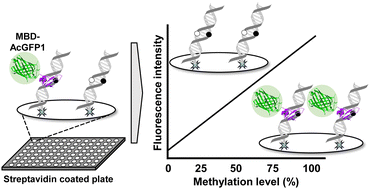Detection of CpG methylation level using methyl-CpG-binding domain-fused fluorescent protein†
Abstract
Methylation of cytosine to 5-methylcytosine on CpG dinucleotides is the most frequently studied epigenetic modification involved in the regulation of gene expression. In normal tissues, tissue-specific CpG methylation patterns are established during development. In contrast, alterations in methylation patterns have been observed in abnormal cells, such as cancer cells. Cancer type-specific CpG methylation patterns have been identified and used as biomarkers for cancer diagnosis. In this study, we developed a hybridization-based CpG methylation level sensing system using a methyl-CpG-binding domain (MBD)-fused fluorescent protein. In this system, the target DNA is captured by a complementary methylated probe DNA. When the target DNA is methylated, a symmetrically methylated CpG is formed in the double-stranded DNA. MBD specifically recognizes symmetrical methyl-CpG on double-stranded DNA; therefore, the methylation level is quantified by measuring the fluorescence intensity of the bound MBD-fused fluorescent protein. We prepared MBD-fused AcGFP1 and quantified the CpG methylation levels of the target DNA against SEPT9, BRCA1, and long interspersed nuclear element-1 (LINE-1) using MBD-AcGFP1. This detection principle can be applied to the simultaneous and genome-wide modified base detection systems using microarrays coupled with modified base binding proteins fused to fluorescent proteins.



 Please wait while we load your content...
Please wait while we load your content...